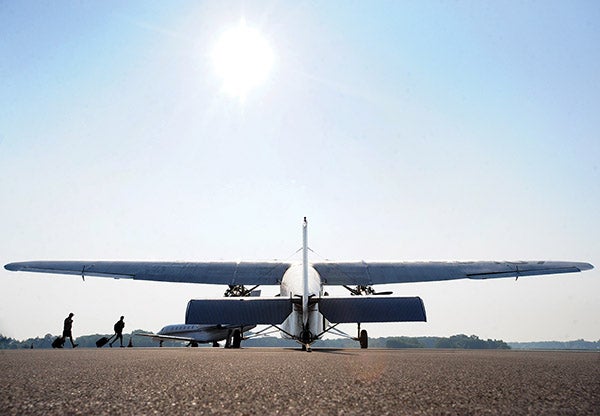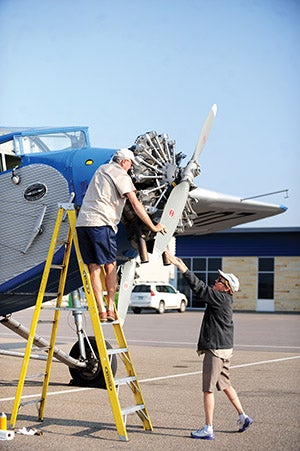Vintage plane flies riders through aviation history
Published 7:01 am Sunday, July 21, 2013

This 1929 Ford Tri-Motor plane is one of two that is still in existance that regularly fly. It landed in Albert Lea on Thursday, July 11, and people were able to ride it throughout the afternoon. Brandi Hagen/Albert Lea Tribune
On Thursday, July 11, a 1929 Ford Tri-Motor 4AT-E was flown into Albert Lea Airport to give residents a chance to see it and experience a flight.

Husband and wife Colin Soucy, left, and Chris Soucy, pull the engine through, a phrase that means cycling oil back through the cylinders. When a plane sits and doesn’t run, the oil drains to the lower cyclinders and to run properly it needs to be cycled back to the top. Brandi Hagen/Albert Lea Tribune
The plane, which calls Pioneer Airport in Oshkosh, Wis., its home, is owned by the Experimental Aircraft Association. It has become a rare find as it is one of two in existence that regularly fly. The second, a Ford Tri-Motor 5AT-E is owned by Kalamazoo Air Zoo in Kalamazoo, Mich.
Chris Soucy, a volunteer from Arnold, Md., who flew the plane to Albert Lea, said there are eight in existence that could fly, and out of the 199 that were made, she estimated a total of 16 to 18 remain.
The Ford Tri-Motor passenger aircraft isn’t as luxurious as air travelers are accustomed to these days.
“She shakes, rattles and rolls,” Soucy said.
The cabin is set up for nine passengers, but if reconfigured could hold up to 13. It’s not pressurized, which means two things. The pilots can have the windows on either side of them open during flight, and the plane has to be flown relatively low at 12,500 feet to maintain oxygen levels. In comparison, a modern day pressurized passenger airplane can fly as high as 30,000 feet.
The Ford Tri-Motor also has to follow visual flight rules. Pilots have to fly low not just because of oxygen. They have to be able to see the horizon to see where they are going. When Soucy and her husband, Colin, flew the plane into Albert Lea, they had with them a paper map, much like a roadmap, to guide them to where they were going.
The plane has a gross weight of a little more than 10,000 pounds, and according to Colin, burns one gallon of fuel per minute. Chris said the plane can be airborne in 600 feet and travels at about 90 miles per hour. In comparison, modern passenger planes when empty weigh about 110,000 pounds and can burn 1,000 gallons of fuel an hour and are airborne in about 1,000 feet.
The Ford Tri-Motor has had a few engines of different sizes installed over its lifetime. The original engines were 300 horsepower Wrights. Then there were 450 horsepower Pratt & Whitney engines, which is what is on the plane now, and for a short period of time, there was a 550 horsepower engine on the front that made it the most powerful 4AT ever flown.
Another difference between the Ford Tri-Motor and modern day passenger planes is that the Ford Tri-Motor has a corrugated skin and exposed cables on the outside of the plane.
Chris described three cables that can be seen. There are ailerons that control the flaps on the wings of the plane, elevator cables that control the nose of the airplane and router cables that help the plane turn.
“It is hard to pilot. It is slow and sluggish and heavy on the controls,” Colin said. “I like to say it flys like a truck and not like a pickup truck, a dump truck.”
Up front on the dash of the plane are gauges that the pilots control during flight.
But only the gauges for the middle engine are located inside the plane. The gauges for the two outside engines are located on the engine so to see them the pilot would have to look backward out the window. Another panel of switches that control the plane are located on the bottom of the co-pilot seat.
Chris said there are no safety concerns with this rare plane. Because it gives rides and is regularly flown, the Ford Tri-Motor has been updated to comply with federal safety regulations.
“We wouldn’t fly it if it wasn’t, trust me,” Chris said. “My last job with the FAA was accident investigation so I’m not climbing on anything that is dicey or questionable.”
The plane does have a slight constant vibration during flight and is very loud, but it’s because of the way it’s built.
Chris added while the plane has three engines, it could easily fly with just two.
And, even though the plane looks vintage like when it was first manufactured, Chris said most of the parts that make it run have been updated.




